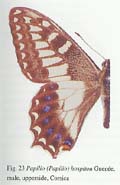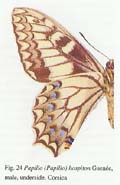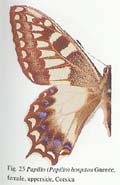|
|
|
Scientific name Papilio (Papililo) hospiton Guenee, 1839
|
|
Chinese name ¬ě¦čąĹ¶Ŕ»ń˝şˇA¬ě¦čąĹ»ń˝şˇC
|
|
English name
Corsican Swallowtail |
|
Classification »ń˝ş¬ě(Papilionidae)ˇA»ń˝ş¨Č¬ě(Papilioninae)ˇA»ń˝ş±Ú(Papilionini)
|
|
Diagnosis
Small-sized swallowtail butterfly. Wingspan 5-6.5 cm.
Belonging to the Papilio machon complex sensu lato and
easily being confused with some subspecies of Papilio
machon and Papilio sikkimensis. Distinguishable from other
similar taxa by having a row of semi-circular submarginal
patch instead of rectangular in other taxa; black area
on hindwings nearly a half of the whole area and very
close to discoidal cell; metallic patches on hindwings
somewhat triangular instead of scattered in other similar
taxa. |
|
Distribution
The Corsican swallowtail butterfly is endemic to the islands
of Sardinia and Corsica where it is widespread and generally
low in density but with some areas of higher local density. |
|
Habitat and Ecology
The butterfly has an open population structure and occurs
in a variety of open landscapes where males display typical
hilltopping behavior. At least three foodplants sustain
populations, from sea level to high elevation, Peucedanum
paniculatum, Ferula communis and Ruta corsica; all are
toxic to grazing mammals and are sustained by traditional
land use, characterized by overgrazing and controlled
burning. These plants have significantly different effects
on the growth rate of P. hospiton, and their distribution
seems to strongly influence the butterflies' density.
|
|
Threats and Conservation Status
It is included in the list of endangered species issued
by the Washington Convention (CITES, 1973). The 'Parc
Regional Naturel de la Haute Corse' provides ecological
supervision which is, on the whole, favourable to the
survival of P. hospiton. At present, there is no evidence
that P. hospiton is experiencing a decline of its populations
and hence it cannot be classified as an endangered species,
as defined by the IUCN. It is however vulnerable, because
it has a restricted range and is very sensitive to land
use changes. Elimination of its hostplants, typically
considered weedy, could almost completely eradicate its
populations within a very short time. There is an obvious
conflict between economic development and conservation
of biodiversity in Corsica as elsewhere. For more detailed
information see Aubert et al. (1996, 1997), Marini &
Trentini (1989), Pierron (1992a) and Trentini & Marini
(1988). |
|
Remarks
|
|
 |
|
|

Papilio (Papilio) hospiton GuenŽe, male,
upperside, Corsica |

Papilio (Papilio) hospiton GuenŽe, male,
underside, Corsica
) |

Papilio (Papilio) hospiton GuenŽe, female,
upperside, Corsica |

Papilio (Papilio) hospiton GuenŽe, female,
underside, Corsica |
|
|
|